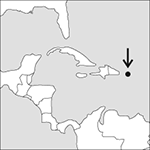
Source: MAPS IN MINUTES™ © RH Publications (1997)
Capital:
San Juan
Area:
13,790 sq km (5324 sq miles)
Population:
3,674,209 (2013 est)
Currency:
1 US dollar = 100 cents
Religions:
Roman Catholic 85.0%; Protestant and other 15.0%
Ethnic Groups:
White 75.8%; Black 12.4%
Languages:
Spanish; English
An island commonwealth in the Caribbean, between Hispaniola and the Virgin Islands.
Physical
The west-east length of Puerto Rico is some 180 km (112 miles), while its north-south width is about 60 km (37 miles) at the widest point. Its climate is tropical. The coast offers good harbours and the coastal plains are fertile, yielding sugarcane, sweet potatoes, and maize. In the interior highlands rise to 1220 m (4000 feet), coffee and tobacco are grown on their slopes.
Economy
The mainstays of the Puerto Rican economy are tourism and manufacturing industry, the major products (and exports) being pharmaceuticals, electronics, clothing, and food products. Nine-tenths of all exports go to the USA. Agriculture is of declining importance. Mineral resources are scanty. More recently manufacturing has declined as a result of the removal of tax advantages and companies relocating to lower-cost countries. Tourism has also declined as Puerto Rico has lost out to other Caribbean destinations. The decline in the economy has forced government cutbacks and also led to very high debt levels of $70 billion. The economy was further devastated by a hurricane in 2017, which did severe damage to infrastructure.
History
Originally known as Boriquén, Puerto Rico was discovered by Columbus in 1493. Encouraged by tales of gold from the indigenous Arawak Indians, his companion, Juan Ponce de León, was granted permission by the Spanish crown to colonize the island. In 1508 he founded the settlement of Caparra and in 1509 he was made governor. Caparra was abandoned and the settlement moved to nearby San Juan in 1521, to take better advantage of the bay for trading. By the end of the 16th century the Arawak were virtually extinct from European-introduced diseases and exploitation. In the 17th and 18th centuries the island remained important for its sugar and tobacco plantations, worked by imported black slaves, and as a key to Spain’s defence of its trading interests in the Caribbean and Atlantic against France, Britain, and Holland.
Puerto Rico was maintained by Spain as a garrison protecting trade routes until the loss of Mexico in 1821 removed its strategic importance. In 1887 the Autonomist Party was founded to protect home rule under Spanish sovereignty. In 1898, during the Spanish–American War, the island came under US military rule and was ceded to the USA at the end of the war. In 1917 an Act of the US Congress (Jones Act) declared Puerto Rican inhabitants to be US citizens. Since the 1940s, with a decline in the sugar industry, there have been successful efforts at industrialization and diversification of the economy. Muñoz Marín (1898–1980) was the first elected governor (1948–64), being re-elected three times. In 1952 the Commonwealth of Puerto Rico was proclaimed, and ratified by a plebiscite. The party which has dominated politics since then, the Popular Democratic Party (PPD), has supported the status quo, while urging greater autonomy. Its rival, the New Progressive Party (PNP) would like the island to become the fifty-first state of the USA. There is also a small Independence Party, but the violent separatist organization, the FALN, has had little support on the island. The UN has regularly urged a plebiscite to decide the island’s future. In 1993, Puerto Ricans voted to retain their country’s status as a self-governing commonwealth, thereby rejecting both independence and US statehood. Another vote in 1998 produced the same result, but in 2012 a majority preferred US statehood. Demands for statehood increased thereafter, as the government had to seek continuing US support to tackle a severe financial crisis caused by excessive government debt. The PNP returned to power in 2017. In September of that year the island was hit by a devastating hurricane, which displaced over 200, 000 people and caused widespread damage. In early 2018 40% of Puerto Rico was still without electricity.
- inherent addressing
- inherently ambiguous language
- inherently safe
- inherent moisture
- inherent weakness failure
- inheritance
- inheritance tax
- inhibin
- inhibit
- inhibiting input
- inhibition
- inhibitory postsynaptic potential
- inhomogeneity
- inhomogeneous
- inhomogeneous differential equation
- inhomogeneous strain
- initial
- initial algebra
- initial conditions
- initial current
- initialization
- initialization string
- initialize
- initial levée
- initial line